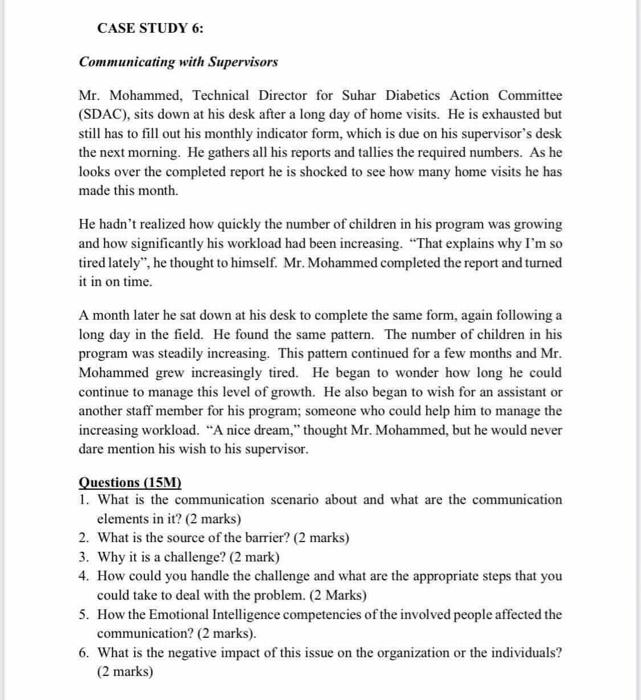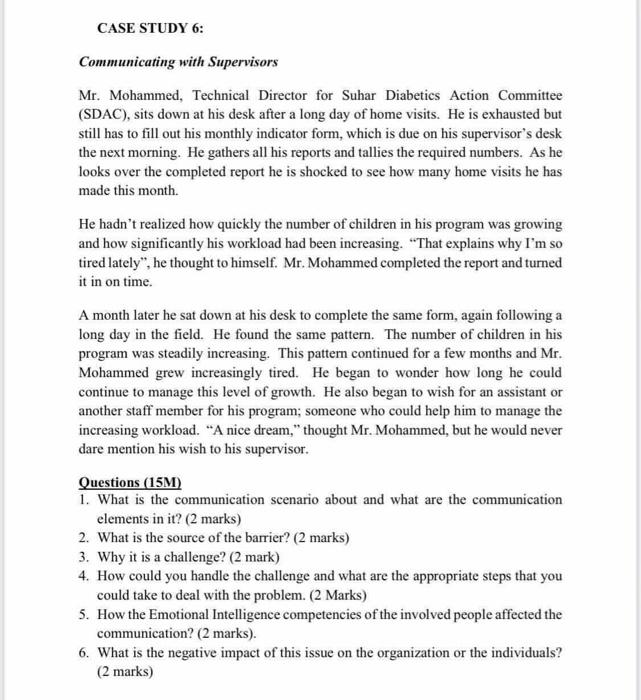CASE STUDY 6: Communicating with Supervisors Mr. Mohammed, Technical Director for Suhar Diabetics Action Committee (SDAC), sits down at his desk after a long day of home visits. He is exhausted but still has to fill out his monthly indicator form, which is due on his supervisor's desk the next morning. He gathers all his reports and tallies the required numbers. As he looks over the completed report he is shocked to see how many home visits he has made this month. He hadn't realized how quickly the number of children in his program was growing and how significantly his workload had been increasing. "That explains why I'm so tired lately", he thought to himself. Mr. Mohammed completed the report and turned it in on time. A month later he sat down at his desk to complete the same form, again following a long day in the field. He found the same pattern. The number of children in his program was steadily increasing. This pattern continued for a few months and Mr. Mohammed grew increasingly tired. He began to wonder how long he could continue to manage this level of growth. He also began to wish for an assistant or another staff member for his program; someone who could help him to manage the increasing workload. "A nice dream," thought Mr. Mohammed, but he would never dare mention his wish to his supervisor. Questions (15M) 1. What is the communication scenario about and what are the communication elements in it? (2 marks) 2. What is the source of the barrier? (2 marks) 3. Why it is a challenge? (2 mark) 4. How could you handle the challenge and what are the appropriate steps that you could take to deal with the problem. (2 Marks) 5. How the Emotional Intelligence competencies of the involved people affected the communication? (2 marks). 6. What is the negative impact of this issue on the organization or the individuals? (2 marks) CASE STUDY 6: Communicating with Supervisors Mr. Mohammed, Technical Director for Suhar Diabetics Action Committee (SDAC), sits down at his desk after a long day of home visits. He is exhausted but still has to fill out his monthly indicator form, which is due on his supervisor's desk the next morning. He gathers all his reports and tallies the required numbers. As he looks over the completed report he is shocked to see how many home visits he has made this month. He hadn't realized how quickly the number of children in his program was growing and how significantly his workload had been increasing. "That explains why I'm so tired lately", he thought to himself. Mr. Mohammed completed the report and turned it in on time. A month later he sat down at his desk to complete the same form, again following a long day in the field. He found the same pattern. The number of children in his program was steadily increasing. This patter continued for a few months and Mr. Mohammed grew increasingly tired. He began to wonder how long he could continue to manage this level of growth. He also began to wish for an assistant or another staff member for his program; someone who could help him to manage the increasing workload. "A nice dream," thought Mr. Mohammed, but he would never dare mention his wish to his supervisor. Questions (15M) 1. What is the communication scenario about and what are the communication elements in it? (2 marks) 2. What is the source of the barrier? (2 marks) 3. Why it is a challenge? (2 mark) 4. How could you handle the challenge and what are the appropriate steps that you could take to deal with the problem. (2 Marks) 5. How the Emotional Intelligence competencies of the involved people affected the communication? (2 marks). 6. What is the negative impact of this issue on the organization or the individuals? (2 marks)








